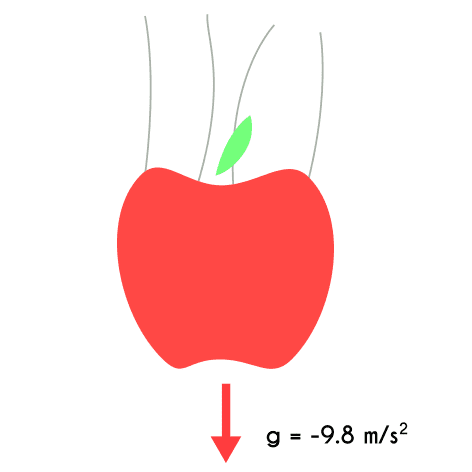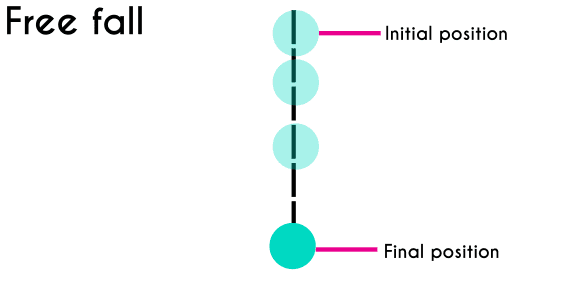Free fall in physics explained, with formulas and examples
This article will be about The free fall motion, with formulas to solve this types of problems, with examples.
Free fall definition
The free fall is a motion that happens when we let something fall from certain height, this motion only happens when the object falls because of its own weight without any initial force or initial velocity, because then we would be talking about a vertical motion.

The free fall is a uniformly accelerated motion that only moves in the vertical axis (“y” axis), with the condition that the initial velocity will always have to be equals to 0 and the acceleration will be the value of the gravity in the place of the motion (9.8m/s). When a free fall motion happens in perfect conditions (this means that there is no air or any other factor that affects the trajectory of the object) the object only moves vertically.
When an object is in free fall, it will star with a 0m/s velocity, but while time passes, the velocity of the object will increase progressively until it impacts the floor or any object that is in its trajectory, this is why, the higher the initial height is, the stronger the impact will be against the floor.
Free fall conditions
The trajectory of an object in free fall could be affected by the air masses, an atmospheric phenomenon also known as aerodynamic resistant. In theory an object in free fall only moves vertically, but because of the air masses the trajectory of the object could change, both vertically and horizontally, how much will the air masses affects the object will depend on the weight of the object, if the object is heavier, then the air masses will not affect the object that much.

Half projectile motion
A half projectile motion is also a type of free fall, the difference is that this motion has horizontal motion, this motion happens when we throw an object from certain height, but only applying force in the horizontal axis, but even though we apply a force to the object, this does not affect the “y” axis motion because the force is only applied in the “x” axis, and the “y” is only moving because of the gravity. An example of this motion could be throwing an arrow from a cliff.
The half projectile motion is the second half of a projectile motion, this is when the object reaches the maximum height and the velocity is equals to 0, and then it starts to fall because of the gravity.
Free fall formulas
As we said before the free fall is a uniformly accelerated motion, but with some defined conditions (gravity equals to 0 and the acceleration equals to the gravity), so the formulas we are going to use in free fall problems are going to be the same as the uniformly accelerated motion, but with some changes, the following formulas are the formulas already with the changes and simplified just to use directly with free fall problems.
- vf = g . t
- y = 1/2g . t2
- vf2 = 2g . y
- y = ( vf /2) . t
Examples of free fall
Example 1: A person drops a rock from 1.75 meters height, Calculate the time that takes to the rock to hit the floor.

- We write the formula and clear the time
- y = -1/2g * t2
- t2 = y / 1/2g
- Then we replace the variables and solve
- t2 = 1.75 / 1/2(9.8)
- t2 = 1.75 / 4.9
- t2 = 0.357
- t = √ 0.357
- t = 0.597
Example 2: If we drop a demolition ball from a 10 meters height, what will be the velocity when it impacts with the floor.

- We write the equation and replace the data
- vf2 = 2g * y
- vf2 = 2(9.8) * 10
- vf2 = 196
- vf = √ 196
- vf = 14 m/s
Example 3: A glass needs to be hit with a velocity of at least 3.7m/s, if this glass falls from a 0.8 meter height table ¿Did the glass broke with the impact?

- We write the equation and replace the variables
- vf2 = 2g * y
- vf2 = 2(9.8) * 0.8
- vf2 = 19.6 * 0.8
- vf2 = 15.68
- vf = √ 15.68
- vf = 3.96 m/s
- Based on the final velocity, the glass indeed broke
Example 4: If we drop a basketball ball from the top of a 44 meters building and we want to score on a basketball hoop that is 3 meters height ¿How much time will it take to the ball to enter in the basketball hoop?

- First we calculate the total distance that the ball will cover
- y = Building height - basketball hoop height
- y = 44m - 3m
- y = 41m
- And now we solve it
- y = 1/2 * g * t2
- we clear the time
- t2 = y / (1/2 * g)
- t2 = 41 / (1/2 * 9.8 m/s)
- t2 = 41 / 4.6
- t2 = 8.91
- t = √ 8.91
- t = 2.98 s
Example 5: A mango falls from a tree that is 5 meters height, if right below the tree is a man that is 1.78m height, calculate the velocity of the impact of the mango with the mans head.

- First we calculate the height
- y = tree height - man height
- y = 5m - 1.78m
- y = 3.22m
- And then we solve it
- vf2 = 2g * y
- vf2 = 2(9.8) * 3.22
- vf2 = 19.6 * 3.22
- vf2 = 63.11
- vf = √ 63.11
- vf = 7.94 m/s